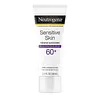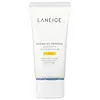What's inside
What's inside
 Key Ingredients
Key Ingredients

 Benefits
Benefits

 Concerns
Concerns

 Ingredients Side-by-side
Ingredients Side-by-side

Titanium Dioxide 4.9%
Cosmetic ColorantZinc Oxide 4.7%
Cosmetic ColorantWater
Skin ConditioningButyloctyl Salicylate
Skin ConditioningBeeswax
Emulsion StabilisingStyrene/Acrylates Copolymer
Silica
AbrasiveButylene Glycol
HumectantPEG-8
HumectantGlyceryl Stearate
EmollientPEG-100 Stearate
Cetyl Dimethicone
EmollientBenzyl Alcohol
PerfumingDimethicone
EmollientMethicone
EmollientArachidyl Alcohol
EmollientPolyhydroxystearic Acid
EmulsifyingHydroxyethyl Acrylate/Sodium Acryloyldimethyl Taurate Copolymer
Emulsion StabilisingPEG-8 Laurate
EmulsifyingXanthan Gum
EmulsifyingIsohexadecane
EmollientBehenyl Alcohol
EmollientTrisiloxane
Skin ConditioningEthylhexylglycerin
Skin ConditioningDisodium EDTA
Trimethylsiloxysilicate
EmollientArachidyl Glucoside
EmulsifyingBisabolol
MaskingDipotassium Glycyrrhizate
HumectantTriethoxycaprylylsilane
BHT
AntioxidantPolysorbate 60
EmulsifyingStearic Acid
CleansingMethylisothiazolinone
PreservativePolyaminopropyl Biguanide
PreservativePolymethyl Methacrylate
Tocopheryl Acetate
AntioxidantAscorbic Acid
AntioxidantPantothenic Acid
Skin ConditioningRetinyl Palmitate
Skin ConditioningAlumina
AbrasiveTitanium Dioxide 4.9%, Zinc Oxide 4.7%, Water, Butyloctyl Salicylate, Beeswax, Styrene/Acrylates Copolymer, Silica, Butylene Glycol, PEG-8, Glyceryl Stearate, PEG-100 Stearate, Cetyl Dimethicone, Benzyl Alcohol, Dimethicone, Methicone, Arachidyl Alcohol, Polyhydroxystearic Acid, Hydroxyethyl Acrylate/Sodium Acryloyldimethyl Taurate Copolymer, PEG-8 Laurate, Xanthan Gum, Isohexadecane, Behenyl Alcohol, Trisiloxane, Ethylhexylglycerin, Disodium EDTA, Trimethylsiloxysilicate, Arachidyl Glucoside, Bisabolol, Dipotassium Glycyrrhizate, Triethoxycaprylylsilane, BHT, Polysorbate 60, Stearic Acid, Methylisothiazolinone, Polyaminopropyl Biguanide, Polymethyl Methacrylate, Tocopheryl Acetate, Ascorbic Acid, Pantothenic Acid, Retinyl Palmitate, Alumina
Butyl Methoxydibenzoylmethane 2.5%
UV AbsorberHomosalate 9%
Skin ConditioningOctocrylene 9%
UV AbsorberEthylhexyl Salicylate 4.5%
UV AbsorberWater
Skin ConditioningPropanediol
SolventButyloctyl Salicylate
Skin ConditioningGlycerin
HumectantDimethicone
EmollientSilica
AbrasiveDiphenylsiloxy Phenyl Trimethicone
Skin ConditioningBehenyl Alcohol
EmollientTrisiloxane
Skin ConditioningVp/Eicosene Copolymer
Cyclopentasiloxane
EmollientTrimethylsiloxysilicate
EmollientC14-22 Alcohols
Emulsion StabilisingCeramide AP
Skin Conditioning1,2-Hexanediol
Skin ConditioningGlyceryl Stearate
EmollientPEG-100 Stearate
Phenyl Trimethicone
Skin ConditioningCetyl Alcohol
EmollientPotassium Cetyl Phosphate
EmulsifyingCaprylyl Methicone
Skin ConditioningPolyacrylate-13
Parfum
MaskingPolyisobutene
C12-20 Alkyl Glucoside
EmulsifyingEthylhexylglycerin
Skin ConditioningDisodium EDTA
Polysorbate 20
EmulsifyingSorbitan Isostearate
EmulsifyingLavandula Angustifolia Flower Water
Skin ConditioningButylphenyl Methylpropional
PerfumingHydroxycitronellal
PerfumingLimonene
PerfumingBenzyl Salicylate
PerfumingAlpha-Isomethyl Ionone
PerfumingGeraniol
PerfumingCitronellol
PerfumingButylene Glycol
HumectantGlucose
HumectantAloe Barbadensis Leaf Extract
EmollientPentylene Glycol
Skin ConditioningCentella Asiatica Flower/Leaf/Stem Extract
Skin ConditioningBrassica Oleracea Italica Extract
AstringentHibiscus Abelmoschus Extract
MaskingMagnesium Sulfate
Calcium Chloride
AstringentTocopherol
AntioxidantXanthan Gum
EmulsifyingCitric Acid
BufferingSodium Benzoate
MaskingPotassium Sorbate
PreservativeManganese Sulfate
Skin ConditioningChenopodium Quinoa Seed Extract
Skin ConditioningZinc Sulfate
AntimicrobialAscorbyl Glucoside
AntioxidantButyl Methoxydibenzoylmethane 2.5%, Homosalate 9%, Octocrylene 9%, Ethylhexyl Salicylate 4.5%, Water, Propanediol, Butyloctyl Salicylate, Glycerin, Dimethicone, Silica, Diphenylsiloxy Phenyl Trimethicone, Behenyl Alcohol, Trisiloxane, Vp/Eicosene Copolymer, Cyclopentasiloxane, Trimethylsiloxysilicate, C14-22 Alcohols, Ceramide AP, 1,2-Hexanediol, Glyceryl Stearate, PEG-100 Stearate, Phenyl Trimethicone, Cetyl Alcohol, Potassium Cetyl Phosphate, Caprylyl Methicone, Polyacrylate-13, Parfum, Polyisobutene, C12-20 Alkyl Glucoside, Ethylhexylglycerin, Disodium EDTA, Polysorbate 20, Sorbitan Isostearate, Lavandula Angustifolia Flower Water, Butylphenyl Methylpropional, Hydroxycitronellal, Limonene, Benzyl Salicylate, Alpha-Isomethyl Ionone, Geraniol, Citronellol, Butylene Glycol, Glucose, Aloe Barbadensis Leaf Extract, Pentylene Glycol, Centella Asiatica Flower/Leaf/Stem Extract, Brassica Oleracea Italica Extract, Hibiscus Abelmoschus Extract, Magnesium Sulfate, Calcium Chloride, Tocopherol, Xanthan Gum, Citric Acid, Sodium Benzoate, Potassium Sorbate, Manganese Sulfate, Chenopodium Quinoa Seed Extract, Zinc Sulfate, Ascorbyl Glucoside
 Reviews
Reviews

Ingredients Explained
These ingredients are found in both products.
Ingredients higher up in an ingredient list are typically present in a larger amount.
Behenyl Alcohol is a type of fatty alcohol (these are different from the drying, solvent alcohols).
Fatty Alcohols have hydrating properties and are most often used as an emollient or to thicken a product. They are usually derived from natural fats and oils; behenyl alcohol is derived from the fats of vegetable oils.
Emollients help keep your skin soft and hydrated by creating a film that traps moisture in.
In 2000, Behenyl Alcohol was approved by the US as medicine to reduce the duration of cold sores.
Learn more about Behenyl AlcoholButylene Glycol (or BG) is used within cosmetic products for a few different reasons:
Overall, Butylene Glycol is a safe and well-rounded ingredient that works well with other ingredients.
Though this ingredient works well with most skin types, some people with sensitive skin may experience a reaction such as allergic rashes, closed comedones, or itchiness.
Learn more about Butylene GlycolButyloctyl Salicylate is a chemical UV filter structurally similar to octisalate. It is a photostabilizer, SPF booster, emollient and solvent. This ingredient helps evenly spread out ingredients.
According to a manufacturer, it is suitable for pairing with micro Titanium Dioxide, Zinc Oxide, and pigments.
Photostabilizers help stabilize UV-filters and prevents them from degrading quickly.
Learn more about Butyloctyl SalicylateDimethicone is a type of synthetic silicone created from natural materials such as quartz.
What it does:
Dimethicone comes in different viscosities:
Depending on the viscosity, dimethicone has different properties.
Ingredients lists don't always show which type is used, so we recommend reaching out to the brand if you have questions about the viscosity.
This ingredient is unlikely to cause irritation because it does not get absorbed into skin. However, people with silicone allergies should be careful about using this ingredient.
Note: Dimethicone may contribute to pilling. This is because it is not oil or water soluble, so pilling may occur when layered with products. When mixed with heavy oils in a formula, the outcome is also quite greasy.
Learn more about DimethiconeDisodium EDTA plays a role in making products more stable by aiding other preservatives.
It is a chelating agent, meaning it neutralizes metal ions that may be found in a product.
Disodium EDTA is a salt of edetic acid and is found to be safe in cosmetic ingredients.
Learn more about Disodium EDTAEthylhexylglycerin (we can't pronounce this either) is commonly used as a preservative and skin softener. It is derived from glyceryl.
You might see Ethylhexylglycerin often paired with other preservatives such as phenoxyethanol. Ethylhexylglycerin has been found to increase the effectiveness of these other preservatives.
Glyceryl Stearate is a mix of glycerin and stearic acid.
It is used to stabilize the mixing of water and oil ingredients. By preventing these ingredients from separating, it can help elongate shelf life. It can also help thicken the product's texture.
As an emollient, it helps soften skin and supports barrier-replenishing ingredients.
In cosmetics, Glyceryl Stearate is often made from vegetable oils or synthetically produced.
This ingredient may not be fungal-acne safe
Fun fact: The human body also creates Glyceryl Stearate naturally.
Learn more about Glyceryl StearatePeg-100 Stearate is an emollient and emulsifier. As an emollient, it helps keep skin soft by trapping moisture in. On the other hand, emulsifiers help prevent oil and water from separating in a product.
PEGS are a hydrophilic polyether compound . There are 100 ethylene oxide monomers in Peg-100 Stearate. Peg-100 Stearate is polyethylene glycol ester of stearic acid.
Silica, also known as silicon dioxide, is a naturally occurring mineral. It is used as a fine, spherical, and porous powder in cosmetics.
Though it has exfoliant properties, the function of silica varies depending on the product.
The unique structure of silica enhances the spreadability and adds smoothness, making it a great texture enhancer.
It is also used as an active carrier, emulsifier, and mattifier due to its ability to absorb excess oil.
In some products, tiny microneedles called spicules are made from silica or hydrolyzed sponge. When you rub them in, they lightly polish away dead skin layers and enhance the penetration of active ingredients.
Learn more about SilicaThis silicone is an emollient. Emollients create a thin film on the skin to prevent moisture from escaping.
It is not soluble in water and helps increase water-resistance in products.
According to a manufacturer, it can blend seamlessly with silicone oils, such as Cyclopentasiloxane.
Learn more about TrimethylsiloxysilicateTrisiloxane is a type of silicone.
Water. It's the most common cosmetic ingredient of all. You'll usually see it at the top of ingredient lists, meaning that it makes up the largest part of the product.
So why is it so popular? Water most often acts as a solvent - this means that it helps dissolve other ingredients into the formulation.
You'll also recognize water as that liquid we all need to stay alive. If you see this, drink a glass of water. Stay hydrated!
Learn more about WaterXanthan gum is used as a stabilizer and thickener within cosmetic products. It helps give products a sticky, thick feeling - preventing them from being too runny.
On the technical side of things, xanthan gum is a polysaccharide - a combination consisting of multiple sugar molecules bonded together.
Xanthan gum is a pretty common and great ingredient. It is a natural, non-toxic, non-irritating ingredient that is also commonly used in food products.
Learn more about Xanthan Gum